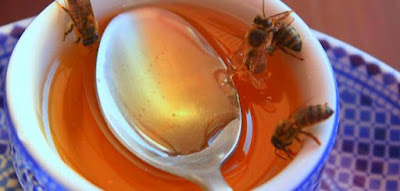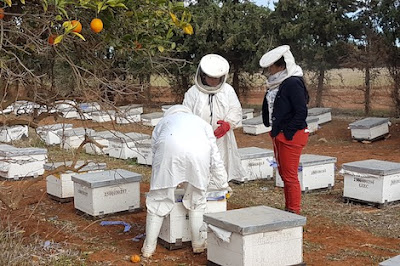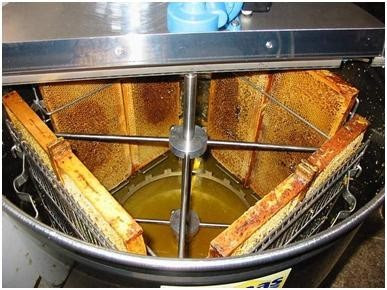bees
are one of the branches of agriculture, one of the most successful agricultural projects, so many farmers who are raising bees to take care of their bees and care to produce honey, wax and royal jelly and vaccinate with high quality, and the spread of bees in all continents of the world. The bees are an insect known for their production of honey, and for their ability to defend themselves or their cells with a painful palpitations. These organisms live all over the planet except Antarctica, which inhabits almost all of the environments on earth. From cold mountainous areas to semi-arid and low-vegetation regions to rainforests. The bees may seem a little scary because they live in large groups and are ferocious in defending their cell, but they are able to work with a very precise system to produce sweet and tasty honey. [1] Bees play an essential role in the environment because it helps flowering plants reproduce. Evolutionally, bees descended from the same strain as wasps, but it differs from it as a development to become an animal that feeds on the nectar of flowers, while wasps are considered to be conscientious.
Honey
is a sweet sticky substance made by bees by processing the nectar of flowers, nectar in nature a light liquid absorbed by bees from flower crowns, and then fly back to his cell to drain it inside. Whole bees can carry nectar with pockets in their legs able to absorb the nectar and store it back to the nest . After bees collect honey in the cell leaves it to dry its fluids takes a thick body, and then add to the chemical substances different give it its unique taste. Honey is an excellent source of simple sugar, so it has been an important economic and trade product since ancient times back thousands of years.
How to Breed Bees
Bees are an insect living all over the world except the frozen poles. Its giant flora consists of more than twenty thousand species and has great economic importance. Human beings have taken honey on honey since the Stone Age, collecting it from the wild. However, humans learned to colonize bees and build simple cells to protect them, and build inside them their wax tablets, in order to obtain a continuous stock of honey. The first cells were probably composed of simple materials, such as pieces of hollow wood or hanging buckets, and the Europeans made bee cells of straw-shaped straw, and it is likely that European explorers transported the honey bees to the Americas during their expeditions there in the early seventh century ten. The honey industry in its current commercial form emerged in the 19th century, when the modern standard cell type was started.
Modern means of beekeeping are two basic ways:
Open culture:
In this way, farmers build bees for boxes of wood according to standard standards that provide bees with the basic specifications and conditions they need in their cell. The most fundamental thing in the design of these cells is the discovery made by Lorenzo Lansergoth in 1852, Gold is equivalent to 8 millimeters. It is absolutely necessary to prevent bees from filling or expanding gaps in the cell wax. The aim is to ensure that bees remain in the form of plates that are easy for farmers to move and move, N possible before the discovery of this method of construction. Modern cells consist of a means of suspension separated from the ground, a base for the construction of wax bees, and then an open box from the top and bottom to place discs on it.
Closed Education:
When a bee-protected environment is not easily available or difficult to transport, it is possible to build a permanent home for it to adopt many bee cells and can be moved to the nectar where necessary.
How to produce honey:
Floral produce liquid substance called nectar to attract insects and birds to help them to reproduce, and nectar is the primary component of honey, a liquid of sugar contains aromatic oils give it a distinctive taste, and these oils are the flowers that give a beautiful smell. The bees collect the nectar by sucking it into special pockets in their legs called "Honey Stomach". Each bee can carry a quantity of nectar up to 40 milligrams. When the universities return to the cell, they give the nectar they have collected to the working bees. The workers begin to evaporate the liquids in the nectar to increase their density and for their wife, and the water is usually reduced from 70% in nectar to only 20% in honey. During this process, the workers swallow the honey and vomit it repeatedly and produce special enzymes that can change its chemical composition, thus increasing its unique aromatic taste and keeping its content from natural sugar.
The final product of honey is characterized by a very thick texture, high viscosity and sweet taste. It contains many kinds of sugars, but it is simple in composition. The flavor and color of the honey may vary depending on the types of flowers it is made. For example, honey made from orange blossoms takes a taste close to the taste of oranges. When honey reaches its final form it is ready to be stored inside the cell for a long time due to its antibacterial properties, and then it is a diet for bees in the winter or in the event of any crisis, which is one of the basic foods eaten by bees.
Honey
is a sweet sticky substance made by bees by processing the nectar of flowers, nectar in nature a light liquid absorbed by bees from flower crowns, and then fly back to his cell to drain it inside. Whole bees can carry nectar with pockets in their legs able to absorb the nectar and store it back to the nest . After bees collect honey in the cell leaves it to dry its fluids takes a thick body, and then add to the chemical substances different give it its unique taste. Honey is an excellent source of simple sugar, so it has been an important economic and trade product since ancient times back thousands of years.
How to Breed Bees
Bees are an insect living all over the world except the frozen poles. Its giant flora consists of more than twenty thousand species and has great economic importance. Human beings have taken honey on honey since the Stone Age, collecting it from the wild. However, humans learned to colonize bees and build simple cells to protect them, and build inside them their wax tablets, in order to obtain a continuous stock of honey. The first cells were probably composed of simple materials, such as pieces of hollow wood or hanging buckets, and the Europeans made bee cells of straw-shaped straw, and it is likely that European explorers transported the honey bees to the Americas during their expeditions there in the early seventh century ten. The honey industry in its current commercial form emerged in the 19th century, when the modern standard cell type was started.
Modern means of beekeeping are two basic ways:
Open culture:
In this way, farmers build bees for boxes of wood according to standard standards that provide bees with the basic specifications and conditions they need in their cell. The most fundamental thing in the design of these cells is the discovery made by Lorenzo Lansergoth in 1852, Gold is equivalent to 8 millimeters. It is absolutely necessary to prevent bees from filling or expanding gaps in the cell wax. The aim is to ensure that bees remain in the form of plates that are easy for farmers to move and move, N possible before the discovery of this method of construction. Modern cells consist of a means of suspension separated from the ground, a base for the construction of wax bees, and then an open box from the top and bottom to place discs on it.
Closed Education:
When a bee-protected environment is not easily available or difficult to transport, it is possible to build a permanent home for it to adopt many bee cells and can be moved to the nectar where necessary.
How to produce honey:
Floral produce liquid substance called nectar to attract insects and birds to help them to reproduce, and nectar is the primary component of honey, a liquid of sugar contains aromatic oils give it a distinctive taste, and these oils are the flowers that give a beautiful smell. The bees collect the nectar by sucking it into special pockets in their legs called "Honey Stomach". Each bee can carry a quantity of nectar up to 40 milligrams. When the universities return to the cell, they give the nectar they have collected to the working bees. The workers begin to evaporate the liquids in the nectar to increase their density and for their wife, and the water is usually reduced from 70% in nectar to only 20% in honey. During this process, the workers swallow the honey and vomit it repeatedly and produce special enzymes that can change its chemical composition, thus increasing its unique aromatic taste and keeping its content from natural sugar.
The final product of honey is characterized by a very thick texture, high viscosity and sweet taste. It contains many kinds of sugars, but it is simple in composition. The flavor and color of the honey may vary depending on the types of flowers it is made. For example, honey made from orange blossoms takes a taste close to the taste of oranges. When honey reaches its final form it is ready to be stored inside the cell for a long time due to its antibacterial properties, and then it is a diet for bees in the winter or in the event of any crisis, which is one of the basic foods eaten by bees.










تعليقات
إرسال تعليق